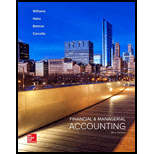
Compute the missing data for Companies X, Y and Z.
Answer to Problem 12E
The missing data for Companies X, Y and Z are as follows:
| Particulars | Company X | Company Y | Company Z | |
| Operating income | $220,000 | e. $1,200,000 | i. $4,800,000 | |
| Sales | a. $687,500 | f. $3,000,000 | j. $9,600,000 | |
| Invested capital | b. $3,437,500 | $6,000,000 | $32,000,000 | |
| Return on sales | 32% | 40% | k. 50% | |
| Capital turnover | 20% | g. 50% | 30% | |
| c. 6.4% | 20% | 15% | ||
| Minimum acceptable return | 10% | 12% | l. 12 % | |
| Residual income (loss) | d. ($123,750) | h. $480,000 | $960,000 | |
Table (1)
Explanation of Solution
Return on investment (ROI): This financial ratio evaluates how efficiently the assets are used in earning income from operations. So, ROI is a tool used to measure and compare the performance of a units or divisions or a companies. The formula for ROI is as follows:
Residual income: Residual income is the excess of income over the minimum acceptable return on average capital invested. The minimum
Capital turnover: Capital turnover is a ratio that measures the amount of sales generated from each dollar of capital investment. Thus, it shows the relationship between the net sales and the average capital invested. The formula to calculate capita turnover is as follows:
Return on sales: This financial ratio evaluates the operating income that can be expected from one dollar of sales. The formula to calculate the return on sales is as follows:
Working Note:
a. Compute sales for Company X.
(1)
b. Compute invested capital for Company X.
(2)
c. Compute return on investment for Company X.
d. Compute residual income for Company X.
e. Compute operating income for Company Y.
(3)
f. Compute sales for Company Y.
g. Compute capital turnover for Company Y.
h. Compute residual income for Company Y.
i. Compute operating income for Company Z.
(4)
j. Compute sales for Company Z.
(5)
k. Compute return on sales for Company Z.
l. Compute minimum acceptable return for Company Z.
Want to see more full solutions like this?
Chapter 25 Solutions
Financial & Managerial Accounting
- < Factory Utilities Indirect Materials Used $1,300 34,500 Direct Materials Used 301,000 Property Taxes on Factory Building 5,100 Sales Commissions 82,000 Indirect Labor Incurred 25,000 Direct Labor Incurred 150,000 Depreciation on Factory Equipment 6,300 What is the total manufacturing overhead?arrow_forwardDiscuss the financial reporting environment and financial statements. What is the purpose of accounting? What impact does the AICPA, FASB, and SEC play in accounting, particularly with regards to the financial statements?arrow_forwardK Sunlight Design Corporation sells glass vases at a wholesale price of $3.50 per unit. The variable cost to manufacture is $1.75 per unit. The monthly fixed costs are $7,500. Its current sales are 27,000 units per month. If the company wants to increase its operating income by 30%, how many additional units must it sell? (Round any intermediate calculations to two decimal places and your final answer up to the nearest whole unit.) A. 7,500 glass vases OB. 33,815 glass vases OC. 6,815 glass vases D. 94,500 glass vasesarrow_forward
- Khayyam Company, which sells tents, has provided the following information: Sales price per unit Variable cost per unit $40 19 $12,800 Fixed costs per month What are the required sales in units for Khayyam to break even? (Round your answer up to the nearest whole unit.) OA. 217 units B. 674 units OC. 610 units D. 320 unitsarrow_forwardPlease need help with this accounting question answer do fastarrow_forwardJingle Ltd. and Bell Ltd. belong to the same industry. A snapshot ofsome of their financial information is given below: Jingle Ltd. Bell Ltd. Current Ratio 3.2 : 1 2 : 1 Acid - Test Ratio 1.7 : 1 1.1 : 1 Debt-Equity Ratio 30% 40% Times Interest earned 6 5 You are a loans officer and both companies have asked for an equal2-year loan. i) If you could facilitate only one loan, which company wouldyou refuse? Explain your reasoning brieflyii) If both companies could be facilitated, would you be willingto do so? Explain your argument briefly.arrow_forward

 AccountingAccountingISBN:9781337272094Author:WARREN, Carl S., Reeve, James M., Duchac, Jonathan E.Publisher:Cengage Learning,
AccountingAccountingISBN:9781337272094Author:WARREN, Carl S., Reeve, James M., Duchac, Jonathan E.Publisher:Cengage Learning, Accounting Information SystemsAccountingISBN:9781337619202Author:Hall, James A.Publisher:Cengage Learning,
Accounting Information SystemsAccountingISBN:9781337619202Author:Hall, James A.Publisher:Cengage Learning, Horngren's Cost Accounting: A Managerial Emphasis...AccountingISBN:9780134475585Author:Srikant M. Datar, Madhav V. RajanPublisher:PEARSON
Horngren's Cost Accounting: A Managerial Emphasis...AccountingISBN:9780134475585Author:Srikant M. Datar, Madhav V. RajanPublisher:PEARSON Intermediate AccountingAccountingISBN:9781259722660Author:J. David Spiceland, Mark W. Nelson, Wayne M ThomasPublisher:McGraw-Hill Education
Intermediate AccountingAccountingISBN:9781259722660Author:J. David Spiceland, Mark W. Nelson, Wayne M ThomasPublisher:McGraw-Hill Education Financial and Managerial AccountingAccountingISBN:9781259726705Author:John J Wild, Ken W. Shaw, Barbara Chiappetta Fundamental Accounting PrinciplesPublisher:McGraw-Hill Education
Financial and Managerial AccountingAccountingISBN:9781259726705Author:John J Wild, Ken W. Shaw, Barbara Chiappetta Fundamental Accounting PrinciplesPublisher:McGraw-Hill Education





